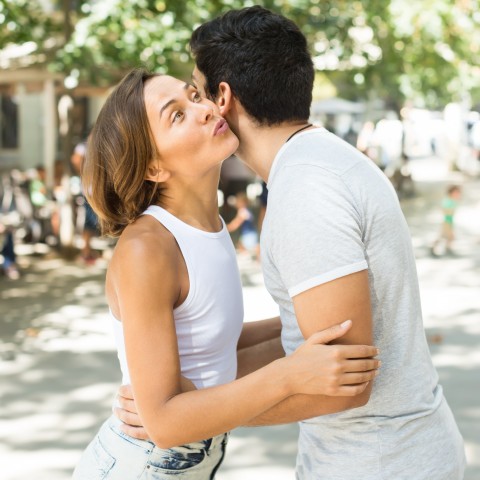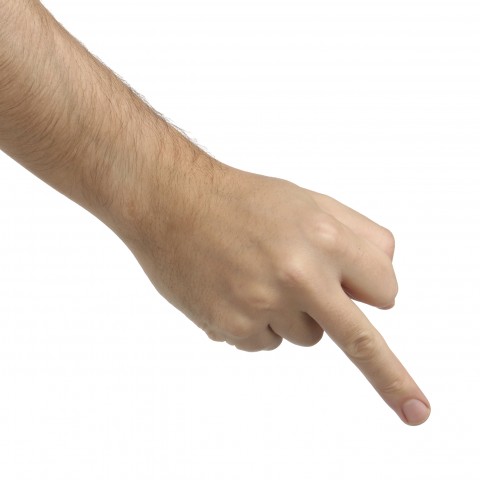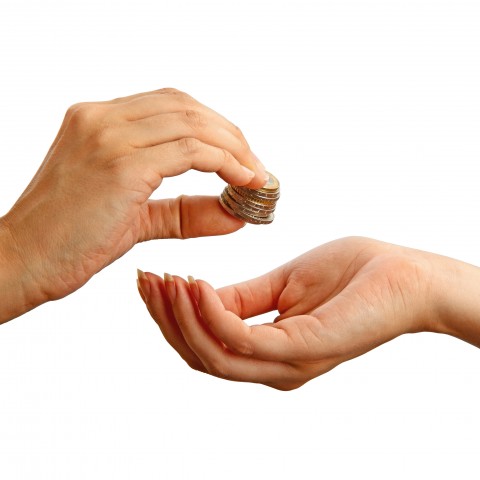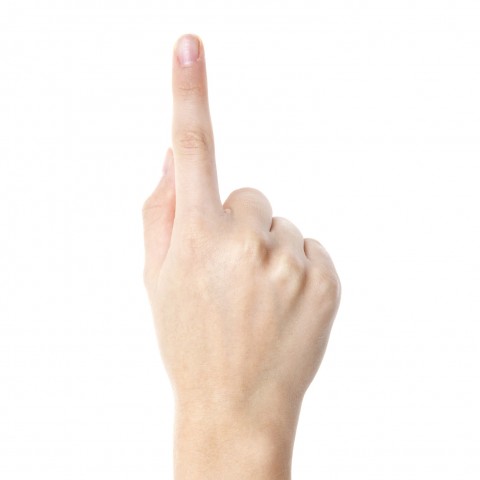Every culture has its own body gestures and language, but sometimes we don’t even realize we do them until someone points it out.
People say you’re not completely fluent in a language until you master idioms, sayings, and gestures, even if they’re not necessary to speak well. We agree that knowing body gestures to improve your Spanish is essential… But there’s a problem: body gestures in Spanish lessons are so hard to come by!
When it comes to some gestures, there’s nothing to worry about, since they’re understood worldwide, such as waving to say hello or goodbye. But then there are others that might leave you a little bit confused. Do you feel like you don’t understand body language in Spanish, or gestures in European countries in general? You’re in the right place, then, because this is where we’re going to help you understand gestures in Spain.
Here’s an example:
What would you think it meant if someone were to hold their palm up as if they were doing karate, and then move it repeatedly toward their stomach while they’re laughing? There’s no need to be scared. They’re not going to cut you in half or anything like that. It just means they thought something was really funny! Would you have guessed that? Maybe, or maybe not.
There are a few more Spanish body language and gestures like this, and some are easier to understand than others. Some of these will generally be accompanied by words, but some won’t. If this sounds a bit confusing, don’t worry. Lucky for you, we’re here to make that process easier. We’ve created this guide so that you can understand these gestures; soon enough, you’ll notice you’re doing them yourself without even thinking about it! Start with a bonus, and download your FREE cheat sheet – How to Improve Your Spanish Skills! (Logged-In Member Only)
Table of Contents
- Three Gestures for Greeting
- Seven Negative Gestures
- Three Positive Gestures
- Six Neutral Gestures
- How SpanishPod101.com Can Help You Learn Spanish
1. Three Gestures for Greeting
Nonverbal communication in Spanish culture starts with greetings! Here are some of the most common Spain gestures and greetings.
1- Hola and Adiós
Meaning: “Hello” and “Goodbye”
How to do: This type of greeting is pretty common. You just need to put one of your hands up, not completely open, and shake from left to right and back at least a couple of times.
When or where to use: You can use this gesture to say hello to someone you see, or goodbye when they’re leaving. If you’re really happy to see them, you can do this movement more energetically and repeatedly.
Take a look at our previous article on How to Say “Hello” in Spanish!
2- Dos besos
Meaning: “Two kisses on the cheeks”
How to do: Kiss a person twice, once on each cheek. But keep in mind that you won’t actually be kissing them, but only pretending to. You must always start by leaning to your left side, which is their right cheek. Notice that in other countries, such as France, they start on the other side.
When or where to use: This greeting is typically used between a woman and a man, or a woman and another woman—or between kids. If you’re two men, but you’re from the same family, you can also give him dos besos.
3- Dar la mano
Meaning: “Handshake”
How to do: Shaking hands in Spain is easy: it’s just a normal handshake. We’re sure you’ve seen this one before, but just in case, all you need to do is hold and shake someone’s hand while facing them.
When or where to use: Shake hands if the greeting is for professional reasons or between two men. It can also mean you’ve just made an agreement.
2. Seven Negative Gestures

As in any country, there are negative body gestures in Spain that you should know and be aware of. These include offensive hand gestures in Spain and Spanish swear gestures! Learn the most common ones here.
1- Así, así, or Regular
Meaning: “So, so”
How to do: Hold your hand open with your palm facing down in front of you, and softly shake it left to right two or three times.
When or where to use: Use this gesture when someone asks you how you’re doing and you’re not doing that great.
2- Te voy a dar
Meaning: “I’m going to get you.”
How to do: Hold your palm up diagonally near your face as if you were going to do some karate, and move your wrist from left to right several times.
When or where to use: If you ask any Spaniard about this gesture, there’s a clear image that they would immediately think of, which is the image of an angry mother coming after you when you’ve been naughty.
3- Dedo medio
Meaning: “Middle finger”
How to do: You know this one! It’s one of the most offensive finger gestures in Spain. Put your middle finger up, facing whoever you want to show it to.
When or where to use: You can use this gesture in different situations, such as when you’re driving and a crazy driver does something dangerous near you. Basically, use it when you’re mad at someone.
4- Caradura
Meaning: “Shameless”
How to do: Open your palm and tap your cheek. The literal meaning of caradura is, in fact, “hard face,” so when you’re doing this, you’re showing how hard that person’s face is.
When or where to use: We’ll give you a very common example. Do any of your friends always manage to avoid paying when you all go out, while everyone else is paying for their part? Surely, we all have one of those. Well, that’s a clear example of a caradura.
5- Estoy harto or Estoy hasta aquí
Meaning: “I’m fed up.”
How to do: Do you know that typical salute you see in movies that soldiers do when they greet a superior? You know, when they move their hand up to their forehead. Well, this gesture obviously has a very different meaning, and it’s not exactly the same, but it’s actually done in a similar way.
You need to hold your hand in the same way, but the position will be horizontal instead of vertical. Estoy hasta aquí literally means “I’m until here.” Because you’re touching your head, it refers to the fact that you’re fed up from toes to head.
When or where to use: The name says it all: you’ll use this gesture when you’re fed up.
6- Está loco/loca
Meaning: “He/she is crazy”
How to do: With your index finger, tap your head on one side a few times, frowning a little.
When or where to use: Once again, it’s all in the name. When you want to point out to someone that they (or someone else) is crazy, you can use this gesture.
7- Dinero
Meaning: “Money”
How to do: This one is quite international. Rub your thumb against your index finger and middle finger.
When or where to use: Use this gesture when talking about money. You can use it to mean that you need money, or that something you’ve seen is very expensive.
3. Three Positive Gestures
1- Partirse de risa
Meaning: “Laugh really hard”
How to do: As we mentioned before, what you need to do is hold your palm up as if you were going to do some karate movement, and then move it at least a couple of times directly to your stomach. Because it refers to something being funny, you’ll normally laugh while you do it.
When or where to use: This gesture can be used after someone tells a joke, or after you or someone else said something funny or silly. You can use it if you actually think what they said was funny, but you can also use it sarcastically, accompanied by a sarcastic “Ha, ha.”
If you want to laugh while you practice your Spanish listening skills, take a look at this list of Spanish comedians.
2- ¡Madre mía!
Meaning: “Oh my God!”
How to do: Hold one of your hands limp, or both hands for emphasis, and waggle it up and down for a few seconds.
When or where to use: The most common use is when you’re about to tell someone some new gossip or something very exciting, as well as after someone says something like this to you.
3- Tirón de orejas
Meaning: “Ear pull”
How to do: With your index finger and thumb, pull a kid’s ear lobule as many times as years he or she is turning that day, while counting them. The last pull is always a bit harder than the others.
When or where to use: As you might have guessed from the previous explanation, you’ll use this gesture when it’s a kid’s birthday.
If you’re feeling confident in Spanish, you might enjoy reading this article on why we pull ears on people’s birthday.
4. Six Neutral Gestures
1- Comer
Meaning: “To eat”
How to do: Hopefully this one will be easy to understand. Do you know that typical Italian hand gesture? Yes, you know, the one you do when you pretend to speak Italian. Well, it’s the same hand gesture, but you direct it to your mouth. And no, you don’t need to do your “Italian face” either.
When or where to use: We use this gesture when we want to ask someone if they would like to eat.
To learn some more about food in Spanish, check out our Top 10 Foods That Will Make You Live Longer and our Top 10 Foods That Will Kill You Faster articles.
2- Mucha gente
Meaning: “Crowded room”
How to do: Hold your palm up, keeping your fingers straight and facing up, and then open and close them a few times.
When or where to use: You can use this gesture, for example, when someone asks you how something you did went, such as a trip or a night out, and you want to describe that there were a lot of people.
3- Pedir la cuenta
Meaning: “Asking for the bill”
How to do: We find this gesture pretty interesting. You have to extend one of your hands with your palm facing up, and then extend your other hand, usually the one you use for writing, and pretend to scribble something on your other hand.
When or where to use: This is the gesture you use to ask for the bill in a restaurant without having to use any words, even though it could also be used while you say: La cuenta, ¿por favor? which means “The bill, please?”
Check out some tips for eating at restaurants in Spain.
4- ¿Lo pillas?
Meaning: “Do you get it?”
How to do: Hold your index finger and thumb up while the rest of your fingers are closed, and pretend to hold an object with them while you twist your wrist towards the other person. Your fingers will be a bit more open than in the image.
When or where to use: We normally use this gesture after telling a joke or a pun.
5- Estar muy delgado or Estar como un fideo
Meaning: “To be skinny”
How to do: There are a couple of very similar options, and both of them include holding your fist up and extending one finger out. One of these versions is to extend your pinky finger, and the other one is to show your index finger. Both mean the same thing, so don’t worry.
When or where to use: You can use this gesture when you’re talking to someone about somebody else who you think is (or became) very skinny, or when you see someone and point out to them that they lost weight, or are thin in general. It can be used in a negative or positive way.
Here are some more words that will help you describe the way someone looks.
6- Ojo or Mira
Meaning: “Watch out” or “Look”
How to do: You need to put your index finger on your cheekbone under your eye, and pull it once or twice.
When or where to use: You can use this gesture when you want to tell your friend to look at something or someone without using words. You can also use it to tell them to be careful.
5. How SpanishPod101.com Can Help You Learn Spanish
We know this might seem complicated, especially when you’re starting to learn a language, but there’s nothing to worry about. As we mentioned before, these gestures aren’t necessary to speak Spanish, or to understand it, but they’re helpful and make communication more natural. We’re sure that by now you understand the importance of body language in Spain!
Were you already familiar with any of these Spanish gestures? Did you learn new ones? Let us know in the comments!
Even if you’re a beginner, you can start practicing and getting familiar with them, but no one is going to judge you if you don’t use them, or if you miss a nonverbal cue in Spanish! If used wrong, however, you might confuse them, so be careful!
But we’re sure you won’t confuse “laughing really hard” with “I’m fed up,” or anything like that, and we’re also sure you won’t use the middle finger without meaning to, especially after reading this guide.
So now you’ve practiced something that’s related to your oral skills, even though they’re actually silent. But what about your reading skills? Check out our Top Ways to Practice Your Spanish Reading Skills. Of course, we can’t forget your listening skills either!
Are you interested in moving to Spain and finding a job there? In that case, we have the perfect article for you.
For some more interesting content, here’s a list of the Top 10 Free Spanish Lessons. Start with a bonus, and download your FREE cheat sheet – How to Improve Your Spanish Skills! (Logged-In Member Only)
















